1993 PONTIAC GRAND-AM radiator
[x] Cancel search: radiatorPage 82 of 306

could damage the tank if it is
completely full
Don’t use radiator antifreeze in
your windshield washer. It can
damage your washer system and
paint
r
Inside Manual DayINight
Rearview Mirror
To reduce glare from lights behind you,
pull the lever toward you
to the night
position.
.. . I
I
Convex Outside Mirror
Your right side mirror is convex.
A convex mirror’s surface is curved so
you can see more from the driver’s seat.
If you aren’t used to a convex
4 mirror, you can hit another
vehicle. A convex mirror can make
things (like other
vehicles) look
farther away
than they really are. If
you cut too sharply into the right
lane, you could hit a vehicle on
your right. Check your inside
mirror or glance
over your .
shoulder before changing lanes.
81
ProCarManuals.com
Page 93 of 306
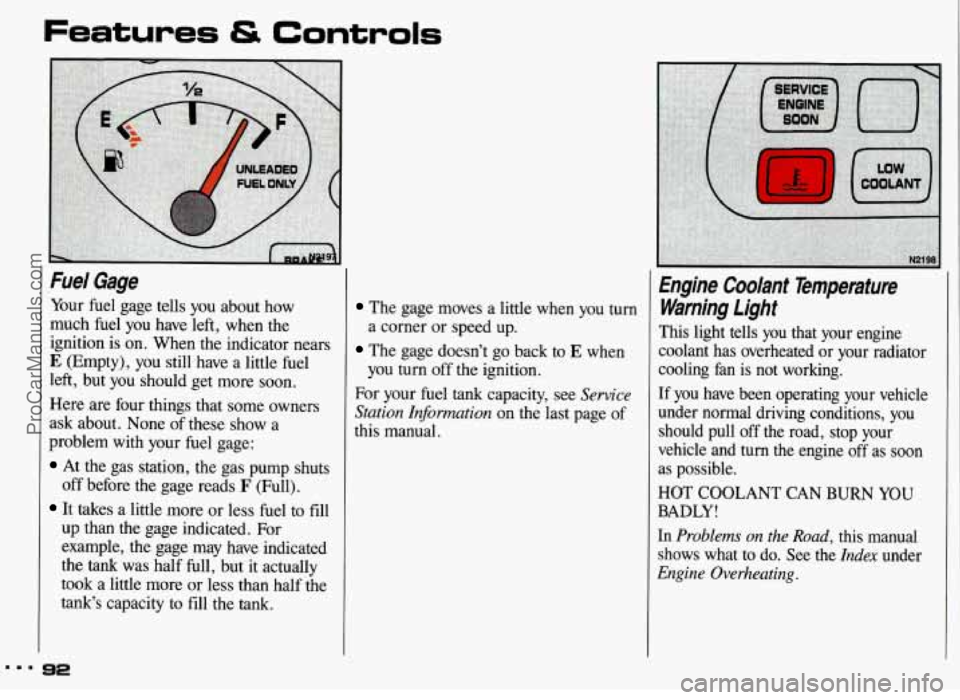
Fuel Gage
Your fuel gage tells you about how
much fuel you have left, when the
ignition is on. When the indicator nears
E (Empty), you still have a little fuel
left, but you should get more soon.
Here are four things that some owners
ask about. None
of these show a
problem with
your fuel gage:
At the gas station, the gas pump shuts
off before the gage reads
F (Full).
It takes a little more or less fuel to fill
up than the gage indicated. For
example, the gage may have indicated
the
tank was half full, but it actually
took a little more or less than half the
tank’s capacity to fill the tank.
The gage moves a little when you turn
The gage doesn’t go back to E when
For your fuel tank capacity, see
Service
Station Information
on the last page of
this manual. a
corner or speed up.
you turn off the ignition.
Engine Coolant Temperature
Warning Light
This light tells you that your engine
coolant has overheated or your radiator
cooling fan is not working.
If you have been operating your vehicle
under normal driving conditions, you
should pull off the road, stop your
vehicle and turn the engine
off as soon
as possible.
HOT
COOLANT CAN BURN YOU
BADLY!
In Problems on the Road, this manual
shows what to do. See the
Index under
Engine Overheating.
ProCarManuals.com
Page 182 of 306
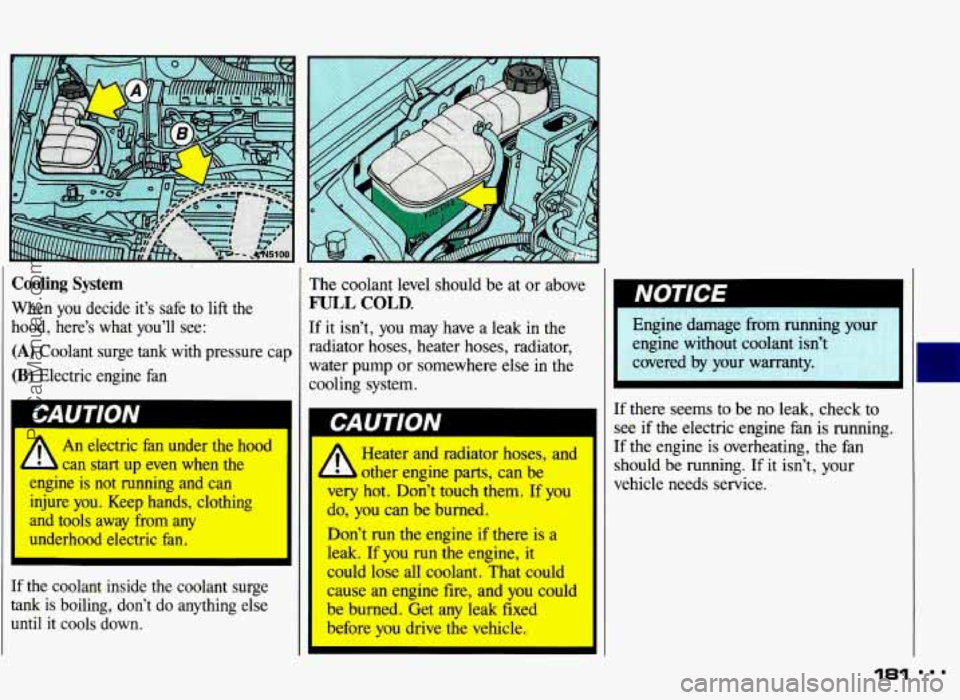
Cooling System
When you decide it’s safe to lift the
hood, here’s what you’ll see:
(A) Coolant surge tank with pressure cap
(B) Electric engine fan
bAU I IVIV
1 /r An electric fan under the hood
- b can start up even when the
engine is not running and can injure you. Keep hands, clothing
and tools away from any
underhood electric fan.
[f the coolant inside the coolant surge
tank is boiling, don’t do anything else
until
it cools down.
’he coolant level should be at or above
TJLL COLD.
f it isn’t, you may have a leak in the
adiator hoses, heater hoses, radiator,
dater pump or somewhere else
in the
ooling system.
A
Heater and radiator hoses, and
other engine parts, can be
very hot. Don’t touch them.
If you
do, you can be burned.
Don’t run the engine if there is a
leak. If
you run the engine, it
could lose all coolant. That could
cause an engine fire, and you could
be burned. Get any leak fixed
before
you drive the vehicle. Engine damage
from
runni
engine without coolant isn’
covered by your warranty.
there seems to be no leak, check
to
x if the electric engine fan is running.
C the engine is overheating, the fan
hould be running.
If it isn’t, your
chicle needs service.
181
ProCarManuals.com
Page 184 of 306
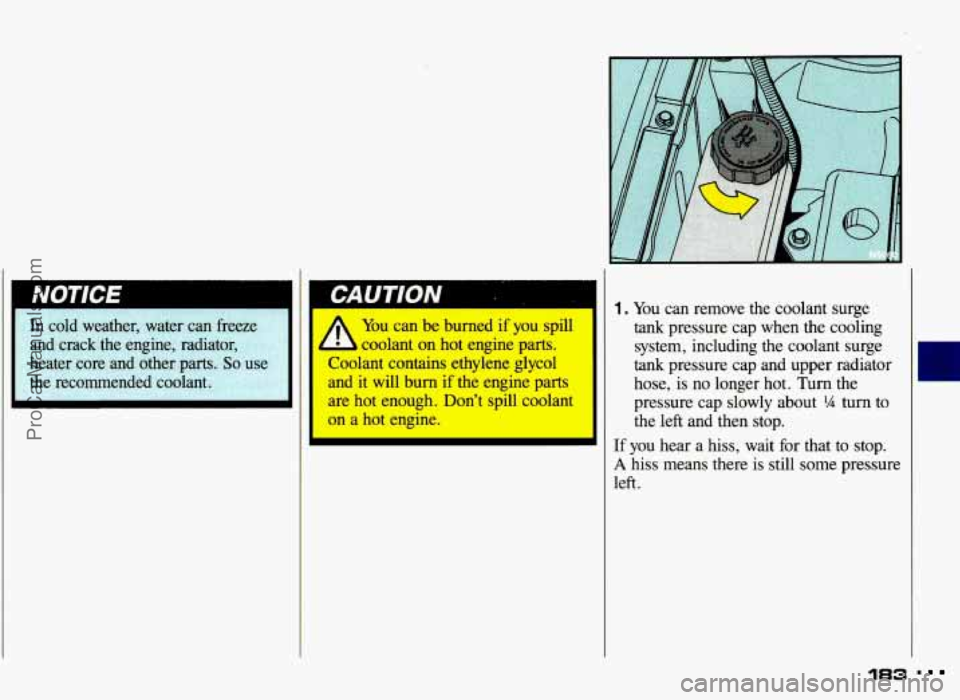
NOTICE
A
You can be burned if you spill
coolant on hot engine
parts.
Coolant contains ethylene glycol
and it will burn if the engine parts
are hot enough. Don’t spill coolant
on a hot engine.
1. You can remove the coolant surge
tank pressure cap when the cooling
system, including the coolant surge
tank pressure cap and upper radiator
hose, is no longer hot. Turn the
pressure cap slowly about
?A turn to
the left and then stop.
If you hear a hiss, wait for that to stop.
A hiss means there is still some pressure
left.
183 .
ProCarManuals.com
Page 185 of 306
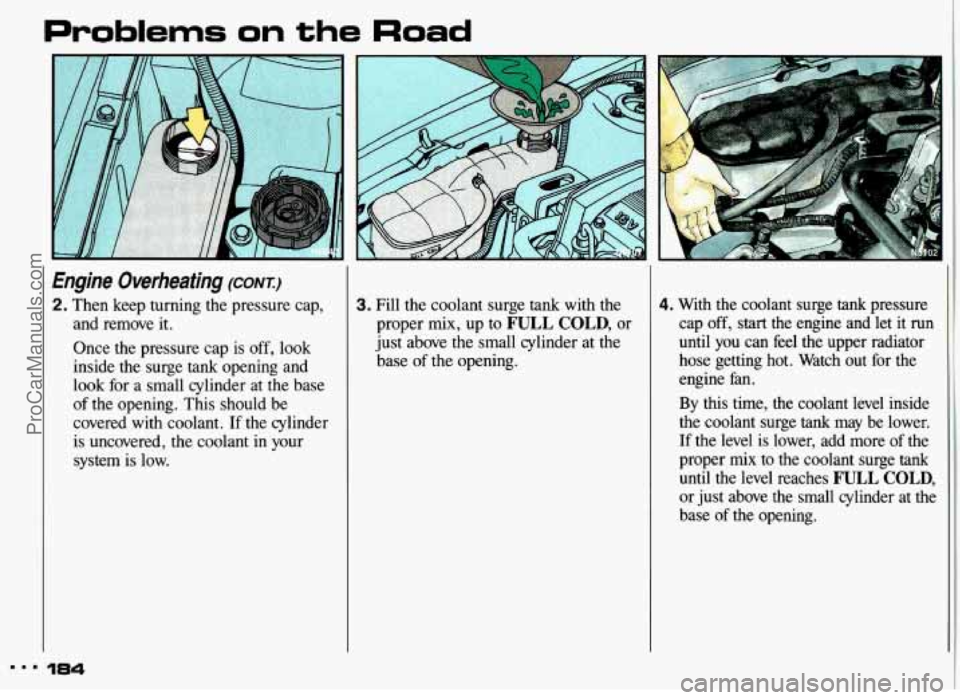
Problems on the Road
,
Engine Overheating (CONT.)
2. Then keep turning the pressure cap, and remove it.
Once the pressure cap is
off, look
inside the surge
tank opening and
look for a small cylinder at the base
of the opening. This should be
covered with coolant. If the cylinder
is uncovered, the coolant in your
system is low.
184
3. Fill the coolant surge tank with the
proper mix, up to
FULL COLD, or
just above the small cylinder at the
base of the opening.
4. With the coolant surge tank pressure
cap off,
start the engine and let it run
until you can feel the upper radiator
hose getting hot. Watch out for the
engine fan.
By this time, the coolant level inside
the coolant surge
tank may be lower.
If the level is lower, add more
of the
proper mix to
the coolant surge tank
until the level reaches F'ULL COLD,
or just above the small cylinder at the
base
of the opening.
ProCarManuals.com
Page 223 of 306
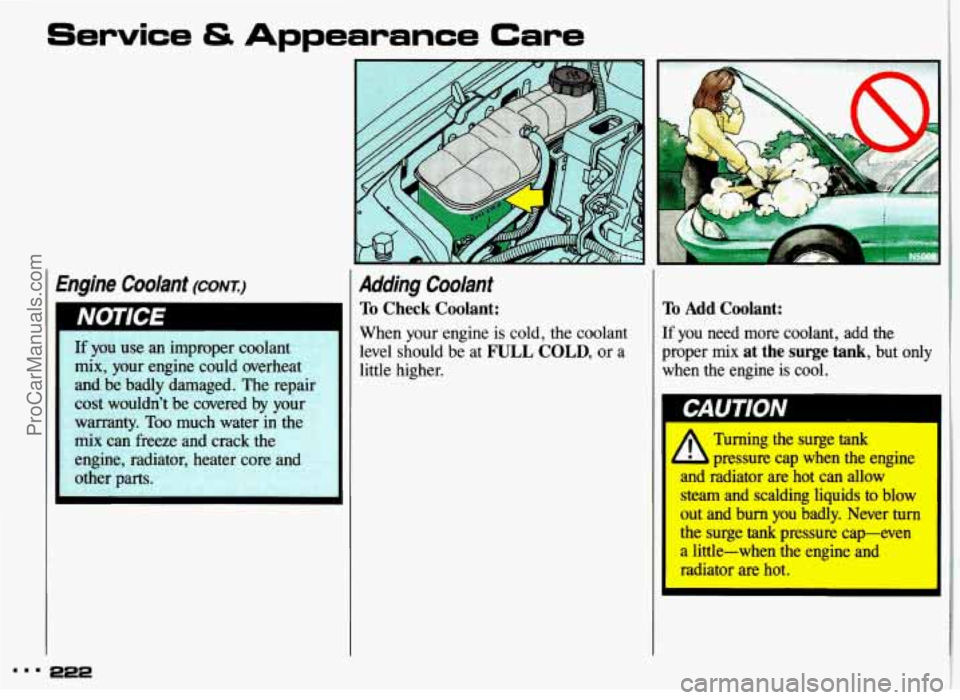
Service & Appearance Care
I Engine Coolant (CONI)
If you use an improper coolant
mix, your engine could overheat
and be badly damaged. The reDair
cost wouldn’t be covered by
yo
warranty. Too much water in the
mix can freeze and crack the
engine, radiator, heater
c ; and
other parts.
Adding Coolant
To Check Coolant:
When your engine is cold, the coolant
level should be at
FULL COLD, or a
little higher.
3
To Add Coolant:
If you need more coolant, add the
proper
mix at the surge tank, but only
when the engine is cool.
II
Turning the surge tank
L pressure cap when the engine
and radiator are hot can allow
sbeam and scalding liquids to blow
out and burn you badly. Never turn
the surge tank pressure capieven
a little-when the engine and I
radiator are hot.
ProCarManuals.com
Page 224 of 306
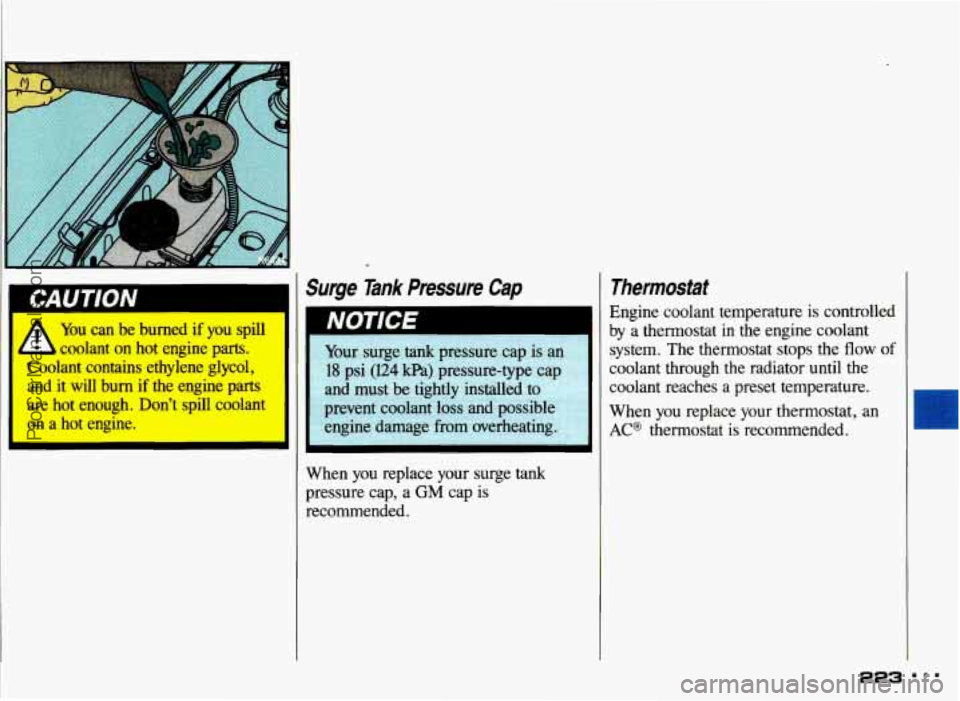
1 CAUTION
A -'-u can be burned if you spill
A Luolant on hot engine parts.
Loolant contains ethylene glycol,
and it will burn if the engine parts
are hot enough. Don't spill coolant
on a hot engine.
Surge Tank Pressure Cap
When you replace your surge tank
pressure cap, a
GM cap is
recommended.
Thermostat
Engine coolant temperature is controlled
by a thermostat
in the engine coolant
system. The thermostat stops the
flow of
coolant through the radiator until the
coolant reaches a preset temperature.
When you replace your thermostat, an
AC@ thermostat is recommended.
ProCarManuals.com
Page 300 of 306

Power Window Lock-Out Switch ... 69
Power Windows
............ .68. 250
Pregnancy. Use of Safety Belts During
...................... 22
Problems On the Road
........... 169
Publications (see
Service Publications)
Radiator Overheating
(see
Overheated Engine)
Radio (see Audio Systems)
Reading Lights ............. .77. 255
Rear Door Security
Locks ......... 47
Rear Seat. Split Fold-Down
........ 12
Rearview Mirrors ................ 81
Rear Window Defogger
.......... 105
Reclining Seatbacks
.............. 10
Remote Fuel Filler Door
......... 203
Remote Trunk Release
............ 49
Replacement Brakes
............. 226
Replacement Bulbs
............. 254
Replacement Fuses
............. 249
Replacement
Parts .............. 257
Replacement, Windshield Wiper
... 230
Replacing Safety Belts
............ 40
Replacing Tires ................ 234 Replacing Wheels
.............. 237
Restraint. Head
.................. 11
Restraints. Child
............ .30. 38
Road Signs
.................... 122
Color
...................... 122
Shape
...................... 123
Symbols
.................... 124
Traffic Lights
................ 124
Traffic Officers
............... 125
Your Own Signs
.............. 125
Roads. Hill and Mountain ........ 152
Roadside Assistance
Program
.................... 285
Rocking Your Vehicle ............ 194
Rotation, Tire
.................. 233
S afety Belts .................... 12
Adults ....................... 17
Center Rear Lap Belt
........... 28
Checking
.................... 30
Children
................. .29, 38
Child Restraints ............... 30
Child Restraints-How to Install
..................... 30
Automatic Lap-Shoulder Belt
..... 18
Child Restraints.
Where to Put .... 30
Cleaning
.................... 242
Driver Position
................ 18
Extender
..................... 40
How to Wear .................. 17
Passenger Belts
................ 22
Pregnancy, Use During
.......... 22
Questions
& Answers . .16, 20, 39, 41
Rear Safety Belts
.............. 23
Replacement
.................. 40
Right Front. Adult Passenger
..... 22
Smaller Children and Babies
..... 29
Top Strap
.................... 31
Torn
........................ 41
Twisted
...................... 21
Vehicles First Sold in Canada
..... 18
Warning Light
................. 17
Why
You Should Wear
Safety Belts
................. 14
Safety Defects. Reporting
......... 284
Scheduled Maintenance Services
... 262
Seat Adjustment
.................. 9
Seat Belts (see
Safety' Belts)
Seat Controls .................... 8
Easy-Entry ................... 11
Head Restraint
................ 11
299 ...
ProCarManuals.com